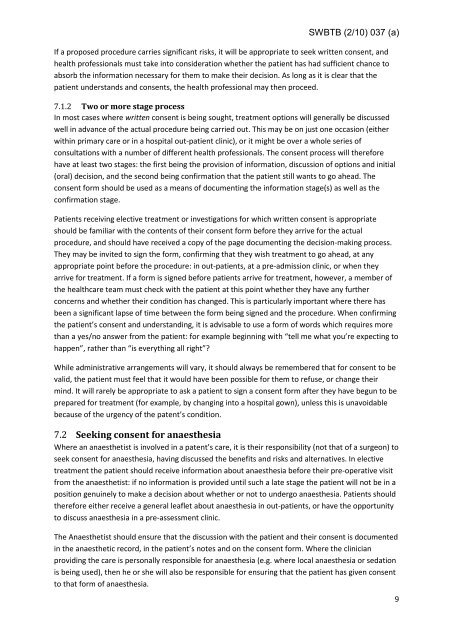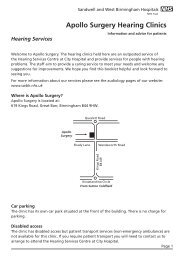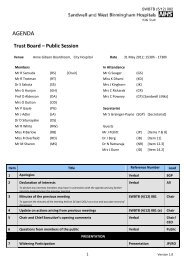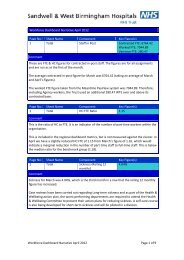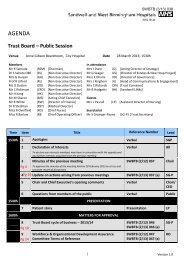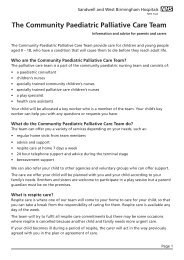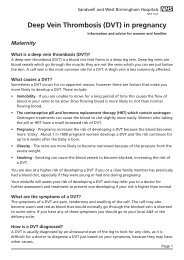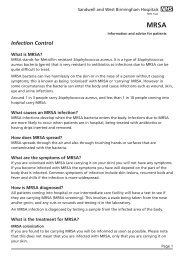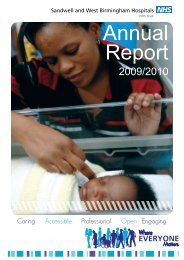Trust Board Febuary 2010 - Sandwell & West Birmingham Hospitals
Trust Board Febuary 2010 - Sandwell & West Birmingham Hospitals
Trust Board Febuary 2010 - Sandwell & West Birmingham Hospitals
Create successful ePaper yourself
Turn your PDF publications into a flip-book with our unique Google optimized e-Paper software.
SWBTB (2/10) 037 (a)<br />
If a proposed procedure carries significant risks, it will be appropriate to seek written consent, and<br />
health professionals must take into consideration whether the patient has had sufficient chance to<br />
absorb the information necessary for them to make their decision. As long as it is clear that the<br />
patient understands and consents, the health professional may then proceed.<br />
7.1.2 Two or more stage process<br />
In most cases where written consent is being sought, treatment options will generally be discussed<br />
well in advance of the actual procedure being carried out. This may be on just one occasion (either<br />
within primary care or in a hospital out-patient clinic), or it might be over a whole series of<br />
consultations with a number of different health professionals. The consent process will therefore<br />
have at least two stages: the first being the provision of information, discussion of options and initial<br />
(oral) decision, and the second being confirmation that the patient still wants to go ahead. The<br />
consent form should be used as a means of documenting the information stage(s) as well as the<br />
confirmation stage.<br />
Patients receiving elective treatment or investigations for which written consent is appropriate<br />
should be familiar with the contents of their consent form before they arrive for the actual<br />
procedure, and should have received a copy of the page documenting the decision-making process.<br />
They may be invited to sign the form, confirming that they wish treatment to go ahead, at any<br />
appropriate point before the procedure: in out-patients, at a pre-admission clinic, or when they<br />
arrive for treatment. If a form is signed before patients arrive for treatment, however, a member of<br />
the healthcare team must check with the patient at this point whether they have any further<br />
concerns and whether their condition has changed. This is particularly important where there has<br />
been a significant lapse of time between the form being signed and the procedure. When confirming<br />
the patient’s consent and understanding, it is advisable to use a form of words which requires more<br />
than a yes/no answer from the patient: for example beginning with “tell me what you’re expecting to<br />
happen”, rather than “is everything all right”?<br />
While administrative arrangements will vary, it should always be remembered that for consent to be<br />
valid, the patient must feel that it would have been possible for them to refuse, or change their<br />
mind. It will rarely be appropriate to ask a patient to sign a consent form after they have begun to be<br />
prepared for treatment (for example, by changing into a hospital gown), unless this is unavoidable<br />
because of the urgency of the patent’s condition.<br />
7.2 Seeking consent for anaesthesia<br />
Where an anaesthetist is involved in a patent’s care, it is their responsibility (not that of a surgeon) to<br />
seek consent for anaesthesia, having discussed the benefits and risks and alternatives. In elective<br />
treatment the patient should receive information about anaesthesia before their pre-operative visit<br />
from the anaesthetist: if no information is provided until such a late stage the patient will not be in a<br />
position genuinely to make a decision about whether or not to undergo anaesthesia. Patients should<br />
therefore either receive a general leaflet about anaesthesia in out-patients, or have the opportunity<br />
to discuss anaesthesia in a pre-assessment clinic.<br />
The Anaesthetist should ensure that the discussion with the patient and their consent is documented<br />
in the anaesthetic record, in the patient’s notes and on the consent form. Where the clinician<br />
providing the care is personally responsible for anaesthesia (e.g. where local anaesthesia or sedation<br />
is being used), then he or she will also be responsible for ensuring that the patient has given consent<br />
to that form of anaesthesia.<br />
9


